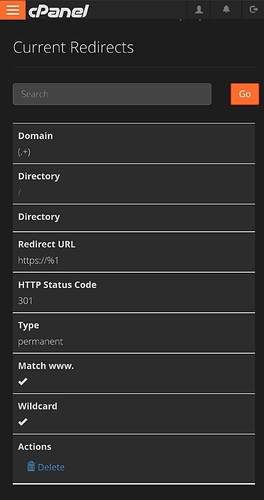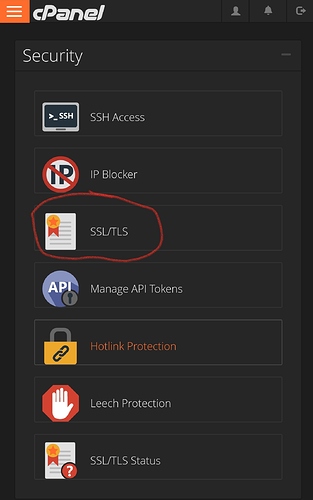I want to renew ssl certificate for orion.eac.edu.ng
Pls, how do I go about it on cpanel
Welcome to the Let's Encrypt Community, Fola 
Does your cPanel support AutoSSL? If not, let us know and we will guide you on using the SSL/TLS tools in the security section to generate a certificate signing request (CSR). It would be very helpful if you could provide the information requested in the form that you deleted when you first created your topic post. It helps us make sure that we give you the right guidance.
Just for reference, you can view your certificate history here:
If you don't know the answers to all of these or some of them don't apply, no worries. Just provide what you can and we'll help you from there.
Please fill out the fields below so we can help you better. Note: you must provide your domain name to get help. Domain names for issued certificates are all made public in Certificate Transparency logs (e.g. https://crt.sh/?q=example.com), so withholding your domain name here does not increase secrecy, but only makes it harder for us to provide help.
My domain is: orion.eac.edu.ng
I ran this command:
It produced this output:
My web server is (include version):
The operating system my web server runs on is (include version):
My hosting provider, if applicable, is:
I can login to a root shell on my machine (yes or no, or I don't know):
I'm using a control panel to manage my site (no, or provide the name and version of the control panel): cPanel
The version of my client is (e.g. output of certbot --version or certbot-auto --version if you're using Certbot):
Hello,
Our Cpanel does not support AutoSSL
Domain: orion.eac.edu.ng
I use cPanel
Hi @folasade
there is an expired certificate.
How did you create that?
Do that again.
PS: Checking your domain you have mixed content - see https://check-your-website.server-daten.de/?q=orion.eac.edu.ng#html-content
The CSS https://orion.eac.edu.ng/content/themes/admin/default/assets/dist/css/style.theme.css is https, but contains a http resource via url("...").
http://cdn1.iconfinder.com/data/icons/cc_mono_icon_set/blacks/16x16/br_down.png
Remove that or change it to https (if exists).
HI,
I tried to install another certificate but get this error on the image attached. What does this mean and how do I fix the problem.
Thank
you
Please read your error message.
The non-www has content, the www version has a Forbidden.
Why? I don't know, you know that, it's your system.
So change that or create a certificate only with the non-www version.
Hi,
I tried creating certificate with the non-www but i get a new error thats attached. Its complaining of a " / " , and I dont know where to fix that. Kindly take a look at the attached image.
You have created that wrong redirect. So you know, where you have created that, change it.
HI,
This is how I did the redirect, by putting the IP address in the DNS, where is the need for " / "
Thank you
That's not a redirect, that's your name server configuration.
The redirect is something http -> https of your webserver.
But I don't use cPanel.
I do use cPanel. I will be back later once I'm home to help.
Hello again, Fola 
I'm so sorry for not getting back to you sooner. I am a regular cPanel user, so I'll do what I can to help. If your cPanel is like mine, you want to click on the Redirects icon in the Domains section.
The next screen will have an interface to create a redirect. You want to scroll down to find the Current Redirects section. Here you can delete redirects. In order to change a redirect, you must first delete the redirect here then add the desired redirect above. Please take screenshots of all the redirects you find here.
For reference, here is the official documentation for cPanel redirects:
Do you actually control www.orion.eac.edu.ng or do you only control orion.eac.edu.ng?
Thank you griffin,
I did the redirect and installed the certificate too.
It is not yet active/validated, the website still shows Not secure.
How long does it take?
Fantastic! ![]()
You need to change your redirect to a 301 Permanent though instead of a 302 Temporary.

It is basically instant. You probably just didn't "install" the certificate.
Be sure to heed Juergen's advice here:
Thank you.
I will check
does http affect the certificate
When a visitor to your website requests your webpage, they will receive the main part of the page securely using your certificate. However, like most webpages, your webpage references some external resources (e.g. pictures, videos, icons, fonts, scripts). Since those resources were not sent with the main part of the page, they are requested separately using their addresses (URLs). If those resources also reference other resources, those must then be requested using their addresses. And so on, which forms a kind of tree with your original webpage being the trunk. Any of those external resources that are requested insecurely (for example, because their addresses use http) can be seen plainly in transport to your visitor because they are not encrypted. This allows bad actors to understand and tamper with these resources before they reach your visitor. Sometimes the potential for direct harm is minimal (e.g. a different picture, video, or font). Other times the potential for direct harm is great (e.g. a different script). We would like to avoid any of these things. This begins with being sure that your webpage always securely requests external resources (i.e. using addresses with https).








